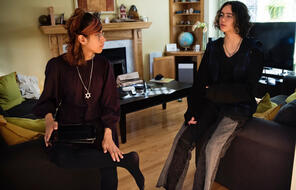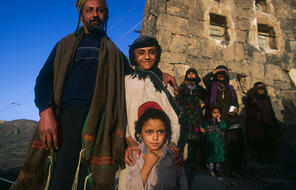A Brief Overview of Mizrahi Jews
At a Glance
Language
English — USSubject
- History
- Social Studies
- Culture & Identity
- Antisemitism
- Equity & Inclusion
Although often confused with Sephardic Jews (because they share many religious customs), Mizrahi Jews have a separate heritage. Mizrahi (in Hebrew, “Eastern” or “Oriental”) Jews come from Middle Eastern ancestry. Their earliest communities date from Late Antiquity, and the oldest and largest of these communities were in modern Iraq (Babylonia), Iran (Persia), and Yemen.
Today, most Mizrahi Jews live either in Israel or the United States. In their new homes, Mizrahi Jews are more likely than other Jews to maintain particularly strong ties with others from their family’s nation of origin. Thus, it is not uncommon to find a specifically Persian or Bukharan synagogue. Likewise, Mizrahi Jews are not united by a single Jewish language; each subgroup spoke its own tongue.
The unique Mizrahi culture has penetrated Israeli mainstream society in recent years. Yemenite music entered the pop scene with Ofra Haza, who blended traditional instruments, rhythms, and lyrics with modern flair. Yemenite silversmiths create sacred objects used by Jews of all backgrounds. “Mizrahi” restaurants — where large platters of skewered meat and breads and bowl upon bowl of salads and condiments are shared by a group — have become fashionable gathering places in Israel.
Despite these trends, Jewish ethnic barriers remain strong. In Israel, Ashkenazic Jews still dominate leadership roles in public institutions. For much of Israel’s history, Sephardic and Mizrahi Jews were disproportionately underrepresented in the government. Yet now, they make up more than half of the population. 1
Since the expulsion of Jews from Spain in the late 15th century, Sephardim and Jews from Arab lands (some who had returned to Israel from Babylonia, now Iraq, during the Second Temple period), were the majority of Jews in the land of Israel, and Sephardic religious practice dominated Jewish life. But beginning in the 1880s, Russian, Polish, and German Jews (all considered Ashkenazic Jews) immigrated to Israel in large numbers.
The Ashkenazim soon became the majority of Jews in Israel, and by 1948 they were 80% of the Jewish population of Israel. Due to their larger numbers, and because modern Zionism, for the most part, originated in Europe, the Ashkenazim became the leaders of the Yishuv, the Jewish community in Palestine. When Israel declared independence in 1948, Sephardim and Jews from Arab lands were almost entirely absent in positions of leadership.
Mizrahi Jews Return to Israel
Following (Israel’s) Independence, as Arab violence forced them to leave their native countries, Mizrahim began to arrive in Israel in huge numbers. The Ashkenazic establishment saw these newcomers as backward “orientals” whose traditions and culture were similar to that of Israel’s enemies, the Arabs, and so Mizrahim were victims of systematic discrimination. Upon arrival in Israel, Mizrahim were sent to transit camps, where living conditions were very difficult. When they moved out of the camps, they were settled in Israel’s least developed neighborhoods.
In Israel’s version of the “melting pot,” Mizrahim were encouraged to conform to the Western Ashkenazic Zionist ideal, mainly via the public schools and the army. Young Mizrahim studied Ashkenazic heritage and historical figures and, in the public religious schools, prayed and practiced Judaism according to Ashkenazic customs. The attitude of David Ben Gurion, the first prime minister of Israel, was typical of the Ashkenazic leadership in the early years of the state: “Those [Jews] from Morocco had no education. Their customs are those of Arabs…The culture of Morocco I would not like to have here…We don’t want Israelis to become Arabs.”
Mizrahi Jews Today
Today, Mizrahim remain significantly poorer than Ashkenazim in Israel. Many still live in the same development towns where they settled in the 1950s and 1960s, and work blue collar jobs. But the role of Mizrahim in Israeli society is changing. Mizrahim now hold positions of power in the Israeli government and army, although these institutions are still dominated by Ashkenazim . . . . 2
- 1“Who Are Mizrahi Jews?,” My Jewish Learning, accessed February 28, 2024.
- 2“Mizrahi Jews in Israel,” My Jewish Learning, accessed February 28, 2024.













